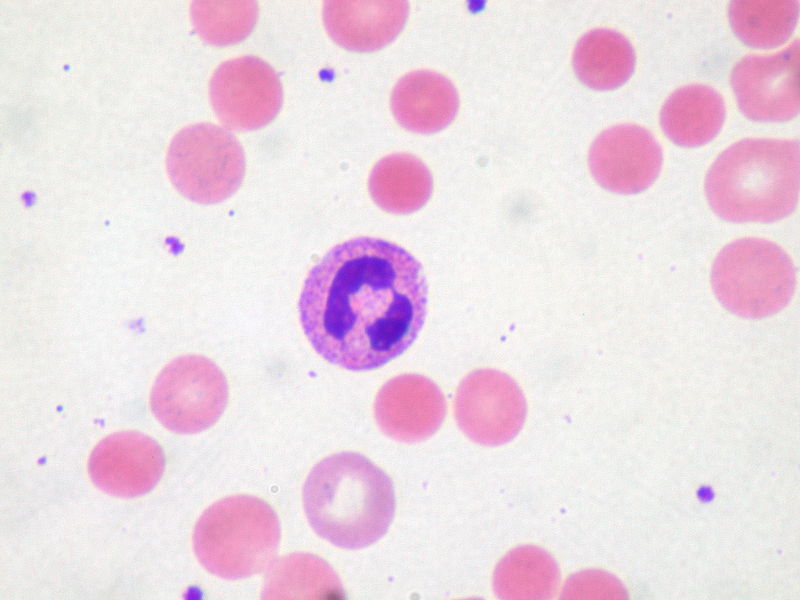Playlist
Show Playlist
Hide Playlist
Autoimmune Hemolytic Anemia (AIHA): Comparison of Direct and Indirect Coombs' Test
-
Slides Autoimmune Hemolytic Anemia.pdf
-
Reference List Pathology.pdf
-
Download Lecture Overview
00:01 Okay, so here are my indications for direct and indirect. 00:03 Close your eyes and tell me about direct. 00:06 What are you trying to identify? The antibody. 00:08 Is it the antibody screen or are you trying to identify the antigen antibody complex? Good. 00:16 In this case, we’re trying to identify the RBC, which is now being attacked or bound pathologically with an IgG. 00:25 That’s the complex we are trying to identify. 00:27 Let’s continue. 00:28 You incubate the patient’s RBCs with anti-IgG or IgM. 00:33 What are those? The Coombs reagent. 00:37 Tell me about this RBC. 00:37 Is it a test RBC or is it the patient's RBC? Look, read. 00:43 Patient RBC. 00:45 It already has the IgG bound to it or IgM bound to it. 00:48 Are we clear? Next, with this Coombs reagent, guess what it binds to? Good, it binds to the IgG. 00:56 Because the Coombs reagent is your anti-IgG. 01:00 If you get positive and it's for IgG, it’s warm. 01:06 If you want to use warm in Georgia, by all means, please do so. 01:10 Or IgM, it’s cold in Michigan especially during winter months. 01:17 So whatever that helps you memorize and always associate IgG – warm and IgM – cold. 01:24 That’s step 1. 01:28 Quickly, I’m just going to give you indirect that is really -- this test is not relevant for us in this lecture series, but it is important in overall medicine. 01:35 In indirect Coombs test, what are you trying to identify? Good. 01:39 The antibody. 01:41 That’s why it’s called an antibody screen. 01:43 Whom? Who’s your population that you’re truly worried about finding antibody? How about maternal prenatal testing? What do you mean? You all have heard of Rh incompatibility, right? Rh incompatibility. 01:57 What goes on with that? Well, it’s the fact that you have a mother who is Rh negative and the fetus is Rh positive. 02:04 The first born, no problem, gets out. 02:07 However, the problem is that the mother who was Rh negative, what does Rh negative mean to you? It means on the RBC membrane, you have antigens. 02:17 If your mother does not have a D antigen, then she is Rh negative. 02:23 What about the fetus? She's holding on to a fetus. 02:29 On the fetus’ RBC membrane, there might be a D antigen. 02:34 What do you call the fetus at that point? Good. 02:36 Rh positive. 02:37 Now the first born will be okay even if she is not getting any treatment, right? The reason for that is because it takes time for the mother to develop antibodies. 02:49 Not to mention even if I had IgM from the mother, is IgM going to cross the placental barrier? Not at all. 02:57 So the first born gets out, but the mother, she forms what? Preformed antibody. 03:03 When we say preformed antibody, what does that mean? IgG. 03:06 Un-oh. 03:07 Now she gets pregnant again. 03:11 She doesn’t have proper access to health care or for whatever reason, she chooses not to get prenatal care. 03:18 So now, she is still Rh negative. 03:20 She hasn’t changed. 03:20 But what about the fetus? The fetus, the second one as well, is also Rh positive. 03:28 This fetus really has no chance of living if she doesn’t get care. 03:32 So what happens to that preformed? What kind of preformed antibodies does a mother have? IgG. 03:36 What does IgG do? Passes right through the placental barrier, huh? And the mother then sees the fetus unfortunately -- the maternal immune system views the fetus as being the enemy, the antigen, that's supposed to be there. 03:53 And so therefore the maternal IgG unfortunately will kill the fetus. 03:58 How? Kernicterus. 03:59 That's something that you have discussed in immunology. 04:03 I’m just quickly repeating this. 04:03 Isn’t it imperative that you do an antibody screen where you can see as to whether or not the Rh negative mother has the antibody that might kill off the fetus? Sure. 04:16 Indirect maternal prenatal testing. 04:19 Prior to a blood transfusion is big. 04:20 Detects unbound anti-RBC antibody. 04:25 Big point, unbound, because this is an antibody screen. 04:30 Patient’s serum is incubated with RBCs of known antigenicity. 04:34 That is not the RBC from the patient. 04:37 Compare that to the RBC in the direct. 04:40 That’s the RBC from the patient. 04:43 If you do have agglutination, then you have positive here. 04:44 But as I said, for our discussion in this lecture series, there are some very important points under indirect Coombs. 04:50 But we will be focusing upon direct Coombs test and how that’s relevant for us to diagnose autoimmune hemolytic anemia.
About the Lecture
The lecture Autoimmune Hemolytic Anemia (AIHA): Comparison of Direct and Indirect Coombs' Test by Carlo Raj, MD is from the course Hemolytic Anemia – Red Blood Cell Pathology (RBC).
Included Quiz Questions
Which of the following Rh blood-type combinations would need an indirect Coombs test for diagnosis?
- Mother is Rh-negative; fetus is Rh-positive
- Mother is Rh-positive; fetus is Rh-positive
- Mother is Rh-positive; fetus is Rh-negative
- Mother is Rh-negative; fetus is Rh-negative
- Mother is Rh-negative; father is Rh-negative
What is the antibody isotype involved in cold autoimmune hemolytic anemia?
- IgM
- IgG
- IgD
- IgE
- IgA
Which of the following statements regarding the Coombs' test is false?
- A direct Coombs' test is appropriate for maternal prenatal testing.
- A direct Coombs' test is appropriate for the diagnosis of cold autoimmune hemolytic anemia.
- An indirect Coombs' test is appropriate for maternal prenatal testing.
- An indirect Coombs' test is appropriate prior to blood transfusion.
- A direct Coombs' test is appropriate for the diagnosis of warm autoimmune hemolytic anemia.
Customer reviews
5,0 of 5 stars
| 5 Stars |
|
2 |
| 4 Stars |
|
0 |
| 3 Stars |
|
0 |
| 2 Stars |
|
0 |
| 1 Star |
|
0 |
the tests are explained to a good detail for having use in clinical practise. Thanks again!
Very clear video of Autoimmune Hemolytic Anemia (AIHA): Comparison of Direct and Indirect Coombs' Test




